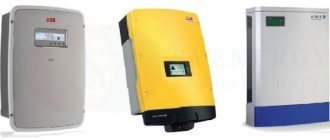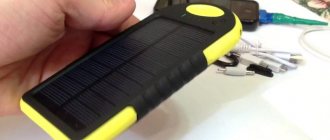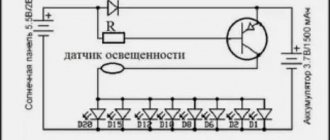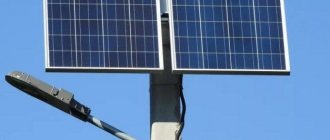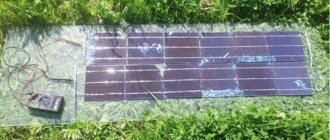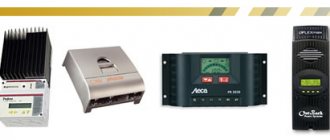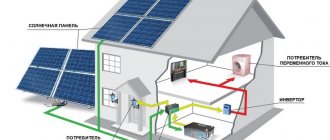You quickly get used to good things, and therefore it is not surprising that the modern generation can no longer imagine itself without tablets, mobile phones and other modern gadgets, especially without a solar-powered Power Bank - an external battery that will help recharge them at any time, so as not to remain without contact.
Description
For everyone who practically never parts with mobile gadgets, this is an extremely useful thing. This solar-powered design reliably stores accumulated energy until the moment it is needed.
It is clear that solar Power Banks Solar, produced by many manufacturers, differ in characteristics and prices, which directly depend on the quality of the energy-saving elements.
It is important that the self-charging device can be replenished with energy not only from sunlight, but also from a regular household network. LED indicators indicate the remaining charge.
Parameters and technical specifications
The choice of external batteries is carried out in accordance with the technical characteristics of a particular device. In addition, operating conditions should be taken into account, primarily the power of mobile devices that will be charged through a power bank.
It is recommended to pay primary attention to the following parameters of the charger:
- Capacity _ The voltage created during charging directly depends on this indicator. A significant portion of the energy is spent operating the circuit used to increase the voltage. In this regard, the stored energy should be additionally taken into account, calculated by the formula 1 Wh = 1 Ah x 1 V. It follows that devices with different output voltages and the same capacity will differ markedly in the amount of stored energy. For example, a battery capacity of 10 thousand mAh does not mean that it will charge a 2000 mAh battery 5 times. In most cases, the energy is enough for two times, since there are significant losses, without which the required voltage cannot be achieved.
- The charge current or its value given by the power bank device. This indicator directly affects the charging time of mobile gadgets. Some external batteries are equipped with two or more USB ports, which have different output currents - from 1 to 2.5 amperes. The specific port is selected in accordance with the device being charged: for a smartphone - 1 A, for a tablet and laptop - 2 and 2.5 A. Incorrect use of ports will increase the charging time.
- Equipped with adapters . Most modern batteries have adapters that fit many mobile devices. The equipment is checked upon purchase or specified in advance via the Internet.
- Methods for charging a power bank . High-quality products can be charged not only from a solar battery, but also from the network. A USB port or a stationary electrical cord is provided for this. It is impossible to quickly charge a high-capacity battery with solar panels alone.
Many buyers pay attention to design solutions and materials used to make the case. Mostly metal or plastic is used. In the first case, the products are expensive, but more reliable, especially with frequent use. There are models whose housing provides protection against moisture and dust getting inside. Additional features most often just draw attention to a particular product. Among them are a flashlight, wireless access points and other bells and whistles that do not bring much benefit and increase the cost of the device.
Choice
When going shopping, it is important to remember the main criteria that must be taken into account when choosing:
- maximum accumulated energy (written on the body of the power bank);
Important: Very often the manufacturer overestimates this indicator for no apparent reason: either for advertising purposes, or based on other indicators. Therefore, it is necessary to make allowances for this and understand that in reality this value will be 80 percent of the indicated value.
- manufacturer. Chargers made in China will please you with their price, but you can expect all sorts of surprises from them.
- price. Models are available in budget versions and more expensive ones, so this is important to consider when choosing a goal. To recharge a mobile phone, for example, at a party, it is enough to purchase a small-capacity model, which is inexpensive. To maintain the functionality of the tablet or use it on a long trip, it is advisable to choose a more serious model.
Minuses
- A solar power bank is essentially the same battery, but uses solar radiation. The disadvantage lies in the fact that if it was not possible to charge the battery during daylight hours, when darkness falls, nothing will shine, literally or figuratively;
- Next is the capacity. It is so small that there is no way to charge powerful devices. On the one hand, it’s good when the external charger has a flashlight, but you need to take into account that it will take some of the energy;
- Non-replaceable battery - the lithium-ion battery is no different from those that are equipped with mobile phones, but if it fails, it is impossible to replace it;
- Solar Power Bank models with a solar battery are inexpensive and have 18650 cells that can be installed and replaced without problems;
- The advantage of the former is the rapid release of accumulated energy and its long-term storage, i.e. they cannot discharge spontaneously;
- Despite the existing shortcomings, for those who like to travel and go on hikes, such chargers are a godsend. Even in a highly discharged state, they will allow you to send an SOS signal.
TOP 8: ROBITON Power Bank LP-8-Solar
Short review
The universal charger, powered by the sun, is equipped with an intelligent controller and 32 bright LEDs, allowing the gadget to act as a lamp. The power bank is compatible with most of the abundant electronic gadgets.
Technical indicators
- Lithium polymer battery – 8000 mAh;
- LED power – 0.06 W;
- Indicator;
- Carbine (included);
- Protected against undercharging, overcharging, short circuit;
- Weight – 235 g;
- LEDs – 32 pcs., 0.06 W;
- Size – 165x15x74 mm;
- Storage temperature – minus 10 – plus 45 degrees;
- Humidity recommended for storage – 65%;
- The recommended operating temperature is 0ºС~40ºС.
Price
It is profitable to buy this model of solar Power Bank on the Internet:
All modern mobile devices – computers, tablets, smartphones and phones – can be recharged from a solar-powered Power Bank.
TOP 7: Solar EK-5
Review
A portable charging device with an LED flashlight will become an indispensable companion for those who are not used to sitting still. It will extend the operation of your favorite devices and help out in any situation in places where there is no electricity.
At the ends there are indicators that notify in time when the battery is low. The solar-powered Power Bank design combines the advantages of external batteries and solar panels.
Frame
It is made of durable plastic, shock-resistant, equipped with protection against excessive charge levels, short circuits, spontaneous discharge and overheating.
The help of the device is invaluable for fishermen, tourists, and business travelers.
You can recharge any gadget anywhere with the falling rays of the sun.
You can also accumulate charge from a 220-volt network in backup battery mode. Cables and adapters for this are included in the kit.
Technical indicators
- Capacity – 16800 mAh;
- Types of devices that can be charged - digital cameras and MP3, MP-4 players, phones, tablets, etc.;
- LED indicator, mini UMS - UMS cable - yes;
- Charging - sunlight and network;
- Input and output voltage – 5V;
- Battery – lithium polymer;
- Dimensions – 160x23x76 mm.
First charge
It is carried out from a PC or network overnight. By morning, the solar power bank indicator is already working.
Price
Folding tourist solar battery for 10 Chinese watts: finding out the real possibilities
A modern real tourist (who walks with a backpack, and not who sits in an all-inclusive foreign hotel) needs electricity while hiking. First of all, it is needed to recharge a smartphone and/or navigator, secondly, to maintain the viability of flashlights, and thirdly, for everything else. Particularly difficult trips may require recharging of satellite communications and rescue equipment (they must be in constant combat readiness, and it is very good if they are not needed). And this is where tourist solar panels come to the rescue (often called tourist solar panels, but it is more correct to call them batteries).
This solar battery of five solar cells was purchased on Aliexpress from this seller, the price at the date of review was $22.3 (may change in the future). There is also a similar battery on sale, but with not five, but with four solar cells. Its price is $20.4, but there is no point in buying it (a significant loss in energy with insignificant savings in cost). The manufacturer claims a power of 10 watts for the battery. But is this so, and exactly how “mistaken” was the manufacturer? We’ll figure it out as the review progresses.
Before moving on to the review, let’s look at the closest competing solution: a power bank with a built-in solar panel.
Comparison of utility of tourist solar panels and power banks with solar panels
You can often find advertisements for power banks with built-in solar panels as camping devices for tourists. They look something like this:
But, dear readers, their usefulness for charging from solar energy is extremely small.
The main , but not the only, reason for their poor suitability for converting solar energy is the small area of the solar cell. Elements of such an area can deliver from 0.5 to 1.5 W of power even in direct sunlight (depending on the area and other factors). As a result, it may take several days to charge a typical power bank with a capacity of 10,000 mAh (37 Wh). And if the weather is not very sunny, then the power bank will not charge at all during the entire trip.
The second reason is the loss of efficiency when transferring charge from the power bank to the smartphone. First, the battery in the power bank must be charged from the solar battery, and then the energy from the power bank battery must be transferred to the smartphone battery. The typical efficiency of power banks when transferring energy to a smartphone is 65-75%. Accordingly, when directly charging a smartphone from a tourist solar battery, these losses will not occur.
The third reason is overheating of the battery in the power bank when charging from direct sunlight. An object lying in the sun can heat up 20-30 degrees or more above the ambient temperature. For lithium-ion batteries, such heating is harmful and leads to premature aging of the battery (with a corresponding loss of capacity if it is charged in this way systematically).
And finally, the last reason, which may not happen: some manufacturers solder the solar panel in power banks directly to the battery, bypassing the controller. In this case, the battery may also suffer from overcharging if you do not suddenly stop charging when it is already charged to 100%. As a result, we can say that such power banks can only be used for charging from sunlight in emergencies, when there is no other way out. In all other cases, it is better to charge such devices in the classic way - from the mains adapter, if you have already become the owner of such a device.
Now we can return to the main subject of the review.
Tourist solar panel design
The tested tourist solar battery consists of 5 solar panels and a controller block of a similar shape, i.e. There are a total of 6 plates in the device. This is what the solar battery looks like when unfolded:
Note the different connecting spaces between the panels. This is done so that when folding the battery you get a neat stack of panels, because When folded, the outer turns are longer than the inner ones.
The panels are connected using very soft leatherette. Interestingly, the panels are not simply inserted into the pockets, but are very tightly glued to the leatherette both on the back and front (along the perimeter). This ensures that the output contacts of the solar panels are protected from moisture. The panels themselves have a matte surface.
It seems that this is a tribute to aesthetics, since it is unlikely that a matte surface will increase efficiency compared to a glossy surface. The size of the active part of each solar panel is 134*65 mm, i.e. 0.871 sq. dm. All five panels are connected in parallel.
Unlike solar panels, the controller unit is not as reliably protected from moisture. The controller unit has two parallel outputs: UBS (universal) and micro-USB (alas, a gradually dying type of connection). The controller has a micro-USB cable built into it with a cord length of 75 mm.
The controller body consists of two plastic halves connected by latches and a pair of screws without gluing or rubber seals. There is a standard USB port at the bottom end of the controller:
To the left of the USB port there is a rectangular hole for visibility of the radiation of the indicator LEDs (their operation will be discussed later).
Let's open the controller housing:
The body halves are connected very tightly, but there are no rubber seals or sizing around the perimeter.
As a result, there is a possibility of moisture ingress if the solar panel is completely submerged in water. Such situations are possible, for example, when wading rivers, capsizing kayaks and other tourist adventures. For such cases, it is recommended to take care of additional protection for the device.
And, of course, leaving the device directly in the rain is also not recommended.
Now let's examine the controller board:
The connections of the board to the solar panels and to the micro-USB output connector are made with a thin stranded wire that is resistant to chafing at bends (as in headphone wires). On the board, in addition to the wiring, there are two chips: a step-down DC-DC converter XL1410E1 and a dual op-amp LM358.
Question: why do you need a converter; or why can’t a smartphone (or other device) be powered directly from a solar battery?
To charge smartphones and most other devices needed by tourists, a voltage of 5 Volts is required. But it is impossible to get exactly 5 Volts from a solar battery - it will change depending on the lighting and load level. Solution to the problem: use solar panels with a higher rated voltage; and bring it to a level of 5 V using a step-down pulse DC-DC converter. Such converters have a higher efficiency than linear ones, and solve the problem of lowering the voltage to the required level with almost no energy loss.
By the way, the XL1410 converter also has thermal protection and short-circuit protection functions, which will also help the device’s survivability in camping conditions. The maximum permissible output current for this converter is 2 Amps.
The op-amp on the board performs the function of completely cutting off the output voltage if the solar panel voltage is too low (lower than approximately 3 V). I’m not sure whether such protection is also needed, but it exists. The open circuit voltage at the output of solar panels under the best lighting conditions, supplied to the input of the converter, is 7.1 V.
There are two LEDs on the board: red and green (in the next photo - in the lower left corner of the board):
Red lights up if there is voltage at the output (ready for operation). Green lights up if a load with a current of 0.28 A or higher is connected to the output.
When folded, the tourist solar battery is quite compact. The kit also includes a carabiner and a compass. Using a carabiner, you can hang the battery on a tree or on the back of a backpack while moving, etc.
As for the compass, it is a very cheap and primitive device; it works poorly, and the needle sometimes gets stuck. In general, it is only suitable as decoration.
Another not very useful part of the kit is an additional 30 cm micro-USB cable. I don’t know why it’s here.
When folded, the solar battery takes up approximately the same amount of space as a typical smartphone with a 5.5-6 inch screen:
For transportation, the solar battery is very compact and takes up little space. Its weight is also very moderate - 260 grams. Now it’s time to evaluate its usefulness when used for its intended purpose - as a source of energy.
Testing a tourist solar panel in conditions close to combat
The tests were carried out in early June at a latitude of 56 degrees N. (this data is very important for the operation of solar panels; more details will be provided in the conclusion). By the way, such large cities as, for example, Nizhny Novgorod, Kazan, Omsk, Novosibirsk, and even Moscow, Copenhagen and Edinburgh are located near this latitude.
An example of using a tourist solar battery in nature:
To create an optimal angle of inclination, you can place something under the battery, for example, a piece of log, as in the photo. But there is no need to place the powered device (smartphone) as in the photo. To avoid overheating, it should be placed in the shade; or at least directly under the same battery.
Let's return to the test methodology.
During testing, the load was increased until the battery output voltage dropped to approximately 4.2 V. This voltage is the maximum charging point for most lithium-ion batteries, i.e. With a lower charger voltage, the batteries will not be able to charge 100%. Under the best conditions (noon, open place, battery orientation perpendicular to the sun's rays), the maximum current that could be squeezed out of the battery was 1.14 A:
In total, the output power was 5.04 Watts, i.e. almost exactly 2 times lower than stated by the manufacturer.
It must be said that such deception is far from the extreme that can be found in advertising of Chinese solar panels. They can claim power 10 times more than the real one!
In addition, it should be noted that all manufacturers of solar panels indicate the output power for “ideal” conditions, which we cannot have: the measurement must be made near the equator exactly at astronomical noon with strictly perpendicular incident rays of the Sun and in an absolutely transparent atmosphere. Such conditions may actually exist in some desert areas of South America (the African Sahara is too dusty).
Let's continue the experiments.
Now - measurement with a horizontal battery position (without tilting towards the Sun):
Power dropped to 4.37 W. That is, it still makes sense to tilt the battery towards the Sun if the weather is cloudless or moderately (not completely) cloudy. As we will see further from the table, the lower the position of the Sun, the more important the correct tilt of the battery.
The table below summarizes the data of these and other measurements in different weather and at different times of day:
| Measurement conditions | Angle of the Sun above the horizon | Solar battery output current |
| Noon, the sun is shining perpendicular to the battery | 57° | 1.14 A |
| Noon, Sun, battery lying horizontally | 57° | 0.99 A |
| 18:00, The sun shines perpendicular to the battery | 23° | 0.93 A |
| 11:00, semi-transparent clouds, battery lying horizontally | 53° | 0.72 A |
| 18:00, Sun, battery lying horizontally | 23° | 0.44 A |
| 11:30, continuous light clouds, battery lying horizontally | 55° | 0.42 A |
| Noon, “torn” cloudiness 5 points, in the shadow of clouds, the battery lies horizontally | 57° | 0.25 A |
| 9:30, overcast and heavy clouds | 44° | 0.07 A |
| Indoor, 10 W LED lamp at a distance of 1 m | — | 0 A (converter did not turn on) |
The angle of the Sun above the surface was calculated using this service.
The moral of this table: battery efficiency is extremely dependent on weather conditions and the correct angle of the battery (can vary significantly). In heavy, overcast conditions the battery becomes virtually useless.
The actual specific energy output from the panel under the best conditions is 1.16 W/sq. dm (from the active surface, excluding the frame, of course). This figure may be useful when evaluating other solar panels.
Possible problems
One of the buyers of this battery noticed that after 6 hours of use in direct sunlight, the edge of the “pocket” of one of the panels peeled off from the panel itself:
It may make sense to place the panel for work in a ventilated place, for example, put something under the panel to create an air gap between the panel and the surface under the battery. It is also better not to place the battery on hot stones, etc. In addition, do not apply shear or tensile force to the battery shell material. This situation is not excluded with other solar panels, with the exception of those that are in hard cases or laminated in plastic. This has not yet happened with the battery we tested, but there hasn’t been much heat in our area yet either.
Results and conclusions
The tested tourist solar battery showed its suitability for use on camping trips, but many nuances must be taken into account.
- The solar battery cannot produce the promised 10 W even in the best conditions (real power is up to 5 W). If you look soberly at its capabilities, then it is able to service only one continuously used device (smartphone, navigator, etc.) during a hike.
- The efficiency of a solar battery (not only this one, but any one in general) is extremely dependent on the season, the angle of inclination of the battery, weather and latitude. For mid-latitudes, it is better not to rely on solar energy during the period from the autumn to the next spring equinox.
- Recommendation: while hiking, you should recharge your main device at every opportunity, without waiting, for example, until the charge reaches 50%. Otherwise, in the event of prolonged deterioration of the weather, recharging will not be possible for a long time.
- It is not forbidden to take with you on a hike, in addition to a solar battery, also a small power bank with a capacity of 5000 - 10000 mAh. It can be useful for economical use in extreme cases (during prolonged bad weather).
- For short-term hikes (or short-term transitions between points of access to an outlet, up to 3 days inclusive), it is better not to mess with solar panels at all, but to take with you 1-2 powerful, well-charged power banks (from 20,000 mAh).
Now let's get back to the positive.
In addition to use on hikes, this solar battery is suitable for recharging mobile devices in a variety of places that are not connected to a centralized source of electricity (tourist shelters, mountain lodges, hunting and fishing huts, etc.).
This solar battery model has several other modifications with different numbers of panels - from 1 to 4. From the point of view of energy and economic utility, there is no point in purchasing batteries with less than 5 panels.
Of course, there are more powerful panels than the one tested in this review, but they also take up more space; and are not always as convenient for transportation.
You can buy this tourist solar panel, for example, here.
Thank you all for your attention!
TOP 6: G-Power STX6000II+Solar Panel 12000 mAh
Description
A solar power bank is designed to charge devices where there is no electricity.
A very compact and truly lightweight solar-powered Power Bank that will not take up much space and will not become an additional burden. Available in several versions - capacity 18000 mAh, 24000, 30000 and more.
A nice bonus is the ability to charge two devices simultaneously. You can charge any portable device with it, for which there are two USB connectors and one micro USB.
The LED indicator helps to judge the remaining charge of the Power Bank on solar batteries.
Price
Why do you need a solar power bank?
Despite its shortcomings, a solar power bank will find its users. Such devices will be relevant for out-of-town trips and travel, where there is no electricity. Depending on the conditions and features of a particular trip, a traveler should choose either a classic power bank or a similar model with a solar battery. For example, when traveling to a large metropolis, a solar panel will be useless, but when climbing mountains it will be indispensable.
TOP 5: SITITEK Sun-Battery SC-10
Review
The unique charger ranks fifth in the TOP-8. The solar power bank differs from its analogues in the increased impact resistance of the case, protection from water and dust. It is equipped with a high-quality monocrystalline panel designed to convert solar rays into electricity.
The battery design is rated at 5000 mAh. It is capable of charging a wide range of portable devices - from phones and players to tablets, etc.
In addition to solar radiation, the device itself can be charged from a 220V household network and a computer.
We recommend:
- The best models of solar panels for charging your phone, equipment, cost and where to buy - TOP 6
- Advantages of solar panels and how to calculate power: examples of calculations for home and garden, basic provisions
- Solar panels: features, technical characteristics, price - TOP 10
For clarity, there is a light indicator showing the charge level. When fully charged, it goes out.
Back panel
The developer gave it an anti-slip structure that will not allow it to slip even on a smooth surface.
Color spectrum
The solar power bank is available to consumers in green, blue and yellow colors.
Even with a strong discharge, making an urgent call with such equipment is not a problem, since it is always possible to recharge the phone, and for free. For this, neither sockets nor wires are needed, because environmentally friendly and affordable solar energy is always available.
All you need to use it is a power bank.
Weight and dimensions
This model has them no more than the devices it can recharge, i.e. The charger fits not only in a woman’s purse, but also in a pocket.
Since the device is capable of accumulating the energy of the Sun, you can recharge the device at any time - even at night. Despite the insignificant thickness of the solar power bank, the capacity of the built-in battery is sufficient.
Charger
If the weather is not sunny, it doesn’t matter, because in addition to the sun, you can charge the device from a PC and the network (via an AC adapter).
Technical indicators
- Battery type – lithium polymer;
- Capacity – 5000 mAh;
- Output voltage - 5V;
- Output current – 1A;
- Dimensions - 142 x 13.6 x 75 mm.
- The housings are made of ABS plastic.
USB port protection
To protect them from dust and moisture, they are reliably protected by a special cover.
Price
Appearance and workmanship
Design also plays a role. It is preferable to choose a metal power bank, because such a device is more durable. However, the cost is higher than that of plastic ones. It is worth paying attention to resistance to water, dirt, dust.
So far, there are not many models that would have both a high-tech design and proper shock resistance and moisture resistance. And those on the market are expensive. For example, devices in a housing made of impact-resistant plastic.
However, if you carry a power bank only around the city, just in case, is it worth spending money on an expensive device for traveling conditions? If you do not pay attention to the characteristics of the case, you can choose a relatively cheap but effective copy.
TOP 4: SITITEK Sun-Battery SC-09
Review
Solar-powered power banks are inexpensive. Despite this, it is capable of charging any portable device anywhere. It allows you to be independent from the power grid.
A small, inexpensive and energy-intensive power bank will help out in any extreme situation, be it a long trip, a camping trip, fishing, etc.
Advantages
- Decent functionality at an affordable price;
- Robust, small-sized housing;
- Three charging options;
- Anti-slip back panel.
Job
Before use, the built-in battery must be fully charged using any of these methods, then connected to the device that needs charging and press the power key.
A corresponding icon should appear on the screen of the gadget being recharged.
To control charging, press the power button and see how many lights are on:
- one corresponds to 25% charge;
- two – 50%, etc.
The solar panel is located on the front side of the solar power bank, indicators and connectors are on the end. Even in cloudy weather, albeit slower, charging will continue. As a last resort, you can use other options.
Technical indicators
- Built-in battery – lithium-polymer;
- Solar panel – mono;
- Output voltage – 5V;
- Output current – 1A;
- Dimensions – 132x15x70 mm;
- Housing – ABS plastic.
Buy
TOP – 3: Battery KS-is KS-225
Review
The external battery runs on solar radiation, is equipped with an LED flashlight and 2 USB ports. Charges all popular gadgets - navigators, tablets, mobile devices, etc.
Characteristics
- Plastics and metal were used to make the case;
- Output current – 1A;
- Keys – activation and indication;
- Size – 80x132x18 mm;
- Input voltage - 5.5 V;
- Maximum panel power – 1.5 W;
- Weight – 210 grams.
Price
TOP 2: Solar EK-1 battery
Portable external charging on a solar panel with two USB outputs and an LED flashlight. Its capacity is increased and reaches 20 thousand mAh.
Technical specifications
- Output current max – 2A;
- Output voltage – 5V;
- Power indicator – LED;
- Size – 120 /75/ 22;
- Battery type – lithium-ion;
- Protection – from overheating, overload, short circuit;
- Operating temperature – 0-45 degrees;
- Weight – 272 grams.
Completeness
- Branded packaging;
- Gadget;
- USB micro cable;
- Solar built-in panel;
- USB connector, LED flashlight - yes.
Buy
With such a device, even in camping conditions where there is no electrical energy, it is possible to recharge any mobile gadget with energy. An easy-to-use device powered by solar energy will bring maximum benefit in any conditions, because it is protected from the penetration of moisture and dust.
It will also prepare a pleasant surprise for the user, allowing you to charge two gadgets at the same time.
Device contents and charging options
The larger the selection of adapters, the wider the range of mobile devices that can be recharged while traveling. Power Bank devices are not deprived of such “things”. Still, when choosing a specific model, ask if the kit includes adapters specifically for your mobile devices. In addition, a reliable external battery must have an additional mains connector for charging from the mains. This is very important, since charging a battery from photocells often takes a long time. What is this connected with?
Many models use thin-film photovoltaic panels, the efficiency of which remains at 4–5% even in clear weather. To quickly charge mobile devices, it is better to purchase batteries with photopanels with a high level of energy efficiency, which have a folding design for easy transportation and storage.
TOP 1: Coosen Power Bank 20000 mAh Solar
Review
The first place in the TOP-8 was taken by a model with a solar battery with a capacity of 10,000 mAh, which is relevant for people who actively use mobile devices. Their charger will activate, releasing the accumulated solar energy or electricity to a regular household network.
For those who do not want to waste precious minutes lying on the couch, but try to learn more while going on long journeys, a high-tech, lightweight and compact device will help out more than once.
Modern electronics have quite a large reserve of their own energy, however, it is discharged at the most inopportune moments. This is where an external battery comes in handy, which will quickly return them to working condition.
No wonder they have gained such wide popularity. With them, you don’t need to frantically search for an outlet to replenish energy on an almost extinguished screen.
pros
The model under consideration compares favorably with its analogues in the following advantages:
- small in size, allowing the gadget to be carried in a handbag or pocket;
- attractive modern design, which is understandable: to recharge an expensive phone it is absurd to use a bulky device. But with an elegant new product, harmony is not disturbed;
- multivariate, i.e. the ability to charge from the sun and 220 V network;
- LED flashlight;
- significant battery capacity. You can charge your gadget several times using this device.
With an autonomous charger, you can stay longer at a party or go overnight into nature without fear of remaining isolated. Absolutely all models of gadgets (even two at the same time) can be powered by a solar-powered Powerbank.
Characteristics
They are no less interesting:
- energy capacity – 20000 mAh;
- battery type – lithium, designed for 600 full charging cycles;
- connectors – micro USB and regular USB (two);
- dimensions – 125x22x75 mm;
- weight – 250 g;
- output voltage – 5V;
- flashlight and adapters – yes;
- temperature range – minus 20-plus 40.
Preparing for work
Before turning on for the first time, the battery must be completely discharged, and then charged to 100%. When the 4 LEDs on the panel light up, this will mean that the battery is ready for use.
The model is compact and very convenient. On the opposite side of the solar battery there is a powerful LED flashlight, the other is located at the end, next to the USB connectors and the battery full energy indicator.
To activate the large flashlight, you need to hold the button at the end; to light up the small one, press it twice. When you press it three times, the flashlight starts working in strobe mode, and when you press it a fourth time, the big one turns off.
In addition to solar radiation, a gadget with a solar panel can use artificial light and daylight for charging.
Price
Other Features
Sometimes the solar-charged device comes with a flashlight and even a hotspot. There is also a charge indicator; there is moisture-resistant material in the case. However, this increases the price. Therefore, you should first make sure that the power bank contains everything you need, and only then think about whether to buy a device with similar functions.

